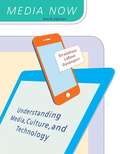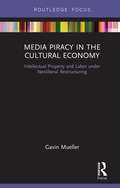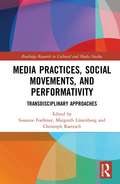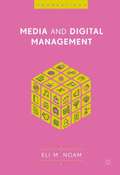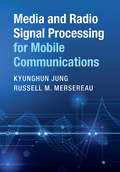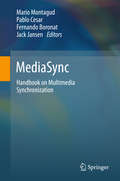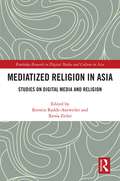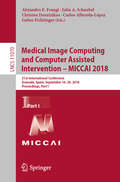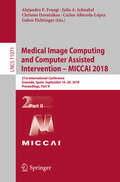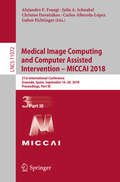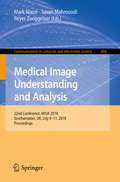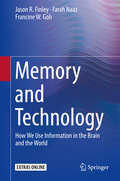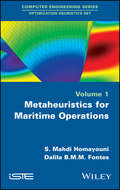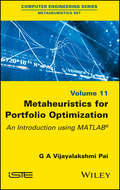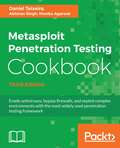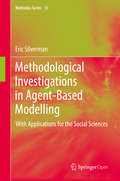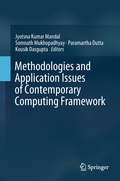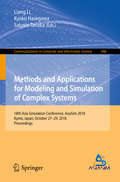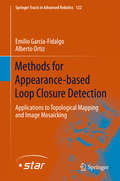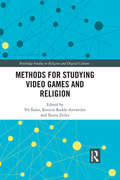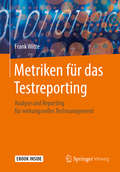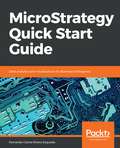- Table View
- List View
Media Now: Understanding Media, Culture, And Technology (Mindtap Course List Series)
by Joseph Straubhaar Lucinda Davenport Robert LaRoseOffering the most current coverage available, MEDIA NOW: UNDERSTANDING MEDIA, CULTURE, AND TECHNOLOGY, 9e equips readers with a thorough understanding of how media technologies develop, operate, converge, and affect society. The text provides a comprehensive introduction to today's global media environment and ongoing developments in technology, culture, and critical theory that continue to transform the rapidly evolving industry−and impact your daily life. Focusing on the essential history, theories, concepts, and technical knowledge, MEDIA NOW develops readers' media literacy skills to prepare them for work in the expanding fields of the Internet, interactive media, and traditional media industries. In addition to vivid infographics and illustrations, the cutting-edge Ninth Edition includes the latest developments and trends in social media, e-publishing, policy changes for Internet governance, online privacy protection, online ad exchanges, the changing video game industry, and much more.
Media Piracy in the Cultural Economy: Intellectual Property and Labor Under Neoliberal Restructuring (Routledge Focus on Digital Media and Culture)
by Gavin MuellerThis book takes a Marxist approach to the study of media piracy – the production, distribution, and consumption of media texts in violation of intellectual property laws – to examine its place as an endemic feature of the cultural economy since the rise of the Internet. The author explores media piracy not in terms of its moral or legal failings, or as the inevitable by-product of digital technologies, but as a symptom of a much larger restructuring of cultural labor in the era of the Internet: labor that is digital, entrepreneurial, informal, and even illegal, and increasingly politicized. Sketching the contours of this new political economy while engaging with theories of digital media, both critical and celebratory, Mueller reveals piracy as a submerged social history of the digital world, and potentially the key to its political reimagining. This significant contribution to the study of piracy and digital culture will be vital reading for scholars and students of critical media studies, cultural studies, political theory, or digital humanities, and particularly those researching media piracy, digital labor, the digital economy, and Marxist theory.
Media Practices, Social Movements, and Performativity: Transdisciplinary Approaches (Routledge Research in Cultural and Media Studies)
by Margreth Lünenborg Susanne Foellmer Christoph RaetzschAs individuals incorporate new forms of media into their daily routines, these media transform individuals’ engagement with networks of heterogeneous actors. Using the concept of media practices, this volume looks at processes of social and political transformation in diverse regions of the world to argue that media change and social change converge on a redefinition of the relations of individuals to larger collective bodies. To this end, contributors examine new collective actors emerging in the public arena through digital media or established actors adjusting to a diversified communication environment. The book offers an important contribution to a vibrant, transdisciplinary, and international field of research emerging at the intersections of communication, performance and social movement studies.
Media and Digital Management
by Eli M. NoamBeing a successful manager or entrepreneur requires creativity, innovation, and performance. It also requires an understanding of the principles and tools of management. Aimed at the college market, this book is a short, foundational volume on media management. It summarizes the major dimensions of a business school curriculum and applies them to the entire media, media-tech, and digital sectors. Its chapters cover—in a jargonless, non-technical way—the major functions of management. First, creating a media product: the financing of projects and the management of technology, HR, production operations, intellectual assets, and government relations. Second, harvesting the product created: market research, marketing, pricing, and distribution. And third, the control loop: media accounting and strategy planning. In the process, this book becomes an indispensable resource for those aiming for a career in the media and digital field, both in startups and established organizations. This book is designed to help those aiming to join the media and digital sector to become creative managers and managerial creatives. It aims to make them more knowledgeable, less blinded by hype, more effective, and more responsible.
Media and Radio Signal Processing for Mobile Communications
by Kyunghun Jung Russell M. MersereauGet to grips with the principles and practise of signal processing used in real mobile communications systems. Focusing particularly on speech and video processing, pioneering experts employ a detailed, top-down analytical approach to outline the network architectures and protocol structures of multiple generations of mobile communications systems, identify the logical ranges where media and radio signal processing occur, and analyze the procedures for capturing, compressing, transmitting and presenting media. Chapters are uniquely structured to show the evolution of network architectures and technical elements between generations up to and including 5G, with an emphasis on maximizing service quality and network capacity through reusing existing infrastructure and technologies. Examples and data taken from commercial networks provide an in-depth insight into the operation of a number of different systems, including GSM, cdma2000, W-CDMA, LTE, and LTE-A, making this a practical, hands-on guide for both practicing engineers and graduate students in wireless communications.
MediaSync: Handbook On Multimedia Synchronization
by Mario Montagud Pablo Cesar Fernando Boronat Jack JansenThis book provides an approachable overview of the most recent advances in the fascinating field of media synchronization (mediasync), gathering contributions from the most representative and influential experts. Understanding the challenges of this field in the current multi-sensory, multi-device, and multi-protocol world is not an easy task. The book revisits the foundations of mediasync, including theoretical frameworks and models, highlights ongoing research efforts, like hybrid broadband broadcast (HBB) delivery and users’ perception modeling (i.e., Quality of Experience or QoE), and paves the way for the future (e.g., towards the deployment of multi-sensory and ultra-realistic experiences). Although many advances around mediasync have been devised and deployed, this area of research is getting renewed attention to overcome remaining challenges in the next-generation (heterogeneous and ubiquitous) media ecosystem. Given the significant advances in this research area, its current relevance and the multiple disciplines it involves, the availability of a reference book on mediasync becomes necessary. This book fills the gap in this context. In particular, it addresses key aspects and reviews the most relevant contributions within the mediasync research space, from different perspectives. Mediasync: Handbook on Multimedia Synchronization is the perfect companion for scholars and practitioners that want to acquire strong knowledge about this research area, and also approach the challenges behind ensuring the best mediated experiences, by providing the adequate synchronization between the media elements that constitute these experiences.
Mediatized Religion in Asia: Studies on Digital Media and Religion (Routledge Research in Digital Media and Culture in Asia)
by Kerstin Radde-Antweiler Xenia ZeilerThis edited volume discusses mediatized religion in Asia, examining the intensity and variety of constructions and processes related to digital media and religion in Asia today. Individual chapters present case studies from various regions and religious traditions in Asia, critically discussing the data collected in light of current mediatization theories. By directing the study to the geographical, cultural and religious contexts specific to Asia, it also provides new material for the theoretical discussion of the pros and cons of the concept mediatization, among other things interrogating whether this concept is useful in non-’Western’ contexts."
Medical Image Computing and Computer Assisted Intervention – MICCAI 2018: 21st International Conference, Granada, Spain, September 16-20, 2018, Proceedings, Part I (Lecture Notes in Computer Science #11070)
by Alejandro F. Frangi Gabor Fichtinger Julia A. Schnabel Christos Davatzikos Carlos Alberola-LópezThe four-volume set LNCS 11070, 11071, 11072, and 11073 constitutes the refereed proceedings of the 21st International Conference on Medical Image Computing and Computer-Assisted Intervention, MICCAI 2018, held in Granada, Spain, in September 2018. The 373 revised full papers presented were carefully reviewed and selected from 1068 submissions in a double-blind review process. The papers have been organized in the following topical sections: Part I: Image Quality and Artefacts; Image Reconstruction Methods; Machine Learning in Medical Imaging; Statistical Analysis for Medical Imaging; Image Registration Methods. Part II: Optical and Histology Applications: Optical Imaging Applications; Histology Applications; Microscopy Applications; Optical Coherence Tomography and Other Optical Imaging Applications. Cardiac, Chest and Abdominal Applications: Cardiac Imaging Applications: Colorectal, Kidney and Liver Imaging Applications; Lung Imaging Applications; Breast Imaging Applications; Other Abdominal Applications. Part III: Diffusion Tensor Imaging and Functional MRI: Diffusion Tensor Imaging; Diffusion Weighted Imaging; Functional MRI; Human Connectome. Neuroimaging and Brain Segmentation Methods: Neuroimaging; Brain Segmentation Methods.Part IV: Computer Assisted Intervention: Image Guided Interventions and Surgery; Surgical Planning, Simulation and Work Flow Analysis; Visualization and Augmented Reality. Image Segmentation Methods: General Image Segmentation Methods, Measures and Applications; Multi-Organ Segmentation; Abdominal Segmentation Methods; Cardiac Segmentation Methods; Chest, Lung and Spine Segmentation; Other Segmentation Applications.
Medical Image Computing and Computer Assisted Intervention – MICCAI 2018: 21st International Conference, Granada, Spain, September 16-20, 2018, Proceedings, Part II (Lecture Notes in Computer Science #11071)
by Alejandro F. Frangi Gabor Fichtinger Julia A. Schnabel Christos Davatzikos Carlos Alberola-LópezThe four-volume set LNCS 11070, 11071, 11072, and 11073 constitutes the refereed proceedings of the 21st International Conference on Medical Image Computing and Computer-Assisted Intervention, MICCAI 2018, held in Granada, Spain, in September 2018. The 373 revised full papers presented were carefully reviewed and selected from 1068 submissions in a double-blind review process. The papers have been organized in the following topical sections: Part I: Image Quality and Artefacts; Image Reconstruction Methods; Machine Learning in Medical Imaging; Statistical Analysis for Medical Imaging; Image Registration Methods. Part II: Optical and Histology Applications: Optical Imaging Applications; Histology Applications; Microscopy Applications; Optical Coherence Tomography and Other Optical Imaging Applications. Cardiac, Chest and Abdominal Applications: Cardiac Imaging Applications: Colorectal, Kidney and Liver Imaging Applications; Lung Imaging Applications; Breast Imaging Applications; Other Abdominal Applications. Part III: Diffusion Tensor Imaging and Functional MRI: Diffusion Tensor Imaging; Diffusion Weighted Imaging; Functional MRI; Human Connectome. Neuroimaging and Brain Segmentation Methods: Neuroimaging; Brain Segmentation Methods.Part IV: Computer Assisted Intervention: Image Guided Interventions and Surgery; Surgical Planning, Simulation and Work Flow Analysis; Visualization and Augmented Reality. Image Segmentation Methods: General Image Segmentation Methods, Measures and Applications; Multi-Organ Segmentation; Abdominal Segmentation Methods; Cardiac Segmentation Methods; Chest, Lung and Spine Segmentation; Other Segmentation Applications.
Medical Image Computing and Computer Assisted Intervention – MICCAI 2018: 21st International Conference, Granada, Spain, September 16-20, 2018, Proceedings, Part III (Lecture Notes in Computer Science #11072)
by Alejandro F. Frangi Gabor Fichtinger Julia A. Schnabel Christos Davatzikos Carlos Alberola-LópezThe four-volume set LNCS 11070, 11071, 11072, and 11073 constitutes the refereed proceedings of the 21st International Conference on Medical Image Computing and Computer-Assisted Intervention, MICCAI 2018, held in Granada, Spain, in September 2018. The 373 revised full papers presented were carefully reviewed and selected from 1068 submissions in a double-blind review process. The papers have been organized in the following topical sections: Part I: Image Quality and Artefacts; Image Reconstruction Methods; Machine Learning in Medical Imaging; Statistical Analysis for Medical Imaging; Image Registration Methods. Part II: Optical and Histology Applications: Optical Imaging Applications; Histology Applications; Microscopy Applications; Optical Coherence Tomography and Other Optical Imaging Applications. Cardiac, Chest and Abdominal Applications: Cardiac Imaging Applications: Colorectal, Kidney and Liver Imaging Applications; Lung Imaging Applications; Breast Imaging Applications; Other Abdominal Applications. Part III: Diffusion Tensor Imaging and Functional MRI: Diffusion Tensor Imaging; Diffusion Weighted Imaging; Functional MRI; Human Connectome. Neuroimaging and Brain Segmentation Methods: Neuroimaging; Brain Segmentation Methods.Part IV: Computer Assisted Intervention: Image Guided Interventions and Surgery; Surgical Planning, Simulation and Work Flow Analysis; Visualization and Augmented Reality. Image Segmentation Methods: General Image Segmentation Methods, Measures and Applications; Multi-Organ Segmentation; Abdominal Segmentation Methods; Cardiac Segmentation Methods; Chest, Lung and Spine Segmentation; Other Segmentation Applications.
Medical Image Computing and Computer Assisted Intervention – MICCAI 2018: 21st International Conference, Granada, Spain, September 16-20, 2018, Proceedings, Part IV (Lecture Notes in Computer Science #11073)
by Alejandro F. Frangi Gabor Fichtinger Julia A. Schnabel Christos Davatzikos Carlos Alberola-LópezThe four-volume set LNCS 11070, 11071, 11072, and 11073 constitutes the refereed proceedings of the 21st International Conference on Medical Image Computing and Computer-Assisted Intervention, MICCAI 2018, held in Granada, Spain, in September 2018. The 373 revised full papers presented were carefully reviewed and selected from 1068 submissions in a double-blind review process. The papers have been organized in the following topical sections: Part I: Image Quality and Artefacts; Image Reconstruction Methods; Machine Learning in Medical Imaging; Statistical Analysis for Medical Imaging; Image Registration Methods. Part II: Optical and Histology Applications: Optical Imaging Applications; Histology Applications; Microscopy Applications; Optical Coherence Tomography and Other Optical Imaging Applications. Cardiac, Chest and Abdominal Applications: Cardiac Imaging Applications: Colorectal, Kidney and Liver Imaging Applications; Lung Imaging Applications; Breast Imaging Applications; Other Abdominal Applications. Part III: Diffusion Tensor Imaging and Functional MRI: Diffusion Tensor Imaging; Diffusion Weighted Imaging; Functional MRI; Human Connectome. Neuroimaging and Brain Segmentation Methods: Neuroimaging; Brain Segmentation Methods.Part IV: Computer Assisted Intervention: Image Guided Interventions and Surgery; Surgical Planning, Simulation and Work Flow Analysis; Visualization and Augmented Reality. Image Segmentation Methods: General Image Segmentation Methods, Measures and Applications; Multi-Organ Segmentation; Abdominal Segmentation Methods; Cardiac Segmentation Methods; Chest, Lung and Spine Segmentation; Other Segmentation Applications.
Medical Image Understanding and Analysis: 22nd Conference, Miua 2018, Southampton, Uk, July 9-11, 2018, Revised Selected Papers (Communications In Computer And Information Science #894)
by Mark Nixon Reyer Zwiggelaar Sasan MahmoodiThis book constitutes the refereed proceedings of the 22st Annual Conference on Medical Image Understanding and Analysis, MIUA 2018, held in Southampton, UK, in July 2018.The 34 revised full papers presented were carefully reviewed and selected from 49 submissions. The papers are organized in topical sections on liver analysis, medical image analysis, texture and image analysis, MRI: applications and techniques, segmentation in medical images, CT: learning and planning, ocular imaging analysis, applications of medical image analysis.
Meme di barzellette divertenti di Fortnite Battle Royale Epic
by Joke FactoryOttieni l’accesso istantaneo alle più divertenti barzellette di Fortnite! Stai per scoprire le più divertenti battute di Fortnite di sempre. Questo libro è ricco di alcune delle barzellette più divertenti di Fortnite. Scopri gli argomenti più popolari di Epic Games insieme a scherzi e meme sciocchi, ridicoli e semplicemente esilaranti su di loro! Scarica la tua copia istantaneamente! Acquista oggi e scopri tutte le barzellette più popolari per Fortnite!
Memory and Technology: How We Use Information in the Brain and the World
by Jason R. Finley Farah Naaz Francine W. GohHow is technology changing the way people remember? This book explores the interplay of memory stored in the brain (internal memory) and outside of the brain (external memory), providing a thorough interdisciplinary review of the current literature, including relevant theoretical frameworks from across a variety of disciplines in the sciences, arts, and humanities. It also presents the findings of a rich and novel empirical data set, based on a comprehensive survey on the shifting interplay of internal and external memory in the 21st century. Results reveal a growing symbiosis between the two forms of memory in our everyday lives.The book presents a new theoretical framework for understanding the interplay of internal and external memory, and their complementary strengths. It concludes with a guide to important dimensions, questions, and methods for future research.Memory and Technology will be of interest to researchers, professors, and students across the disciplines of psychology, philosophy, library and information science, human factors, media and cultural studies, anthropology and archaeology, photography, and cognitive rehabilitation, as well as anyone interested in how technology is affecting human memory._____ "This is a novel book, with interesting and valuable data on an important, meaningful topic, as well as a gathering of multidisciplinary and interdisciplinary ideas...The research is accurately represented and inclusive. As a teaching tool, I can envision graduate seminars in different disciplines drawing on the material as the basis for teaching and discussions." Dr. Linda A. Henkel, Fairfield University "This book documents the achievements of a vibrant scientific project – you feel the enthusiasm of the authors for their research. The organization of the manuscript introduces the reader into a comparatively new field the same way as pioneering authors have approached it." Prof. Dr. Wolfgang Schönpflug, Freie Universität Berlin
Metaheuristics for Maritime Operations
by S. Mahdi Homayouni Dalila B.M.M. FontesMetaheuristic Algorithms in Maritime Operations Optimization focuses on the seaside and port side problems regarding the maritime transportation. The book reviews and introduces the most important problems regarding the shipping network design, long-term and short-term scheduling and planning problems in both bulk and container shipping as well as liquid maritime transportation. Application of meta heuristic algorithm is important for these problems, as most of them are hard and time-consuming to be solved optimally.
Metaheuristics for Portfolio Optimization: An Introduction using MATLAB
by G. A. Vijayalakshmi PaiThe book is a monograph in the cross disciplinary area of Computational Intelligence in Finance and elucidates a collection of practical and strategic Portfolio Optimization models in Finance, that employ Metaheuristics for their effective solutions and demonstrates the results using MATLAB implementations, over live portfolios invested across global stock universes. The book has been structured in such a way that, even novices in finance or metaheuristics should be able to comprehend and work on the hybrid models discussed in the book.
Metasploit Penetration Testing Cookbook: Evade antiviruses, bypass firewalls, and exploit complex environments with the most widely used penetration testing framework, 3rd Edition
by Abhinav Singh Monika Agarwal Nipun Jaswal Daniel TeixeiraOver 100 recipes for penetration testing using Metasploit and virtual machines Key Features Special focus on the latest operating systems, exploits, and penetration testing techniques Learn new anti-virus evasion techniques and use Metasploit to evade countermeasures Automate post exploitation with AutoRunScript Exploit Android devices, record audio and video, send and read SMS, read call logs, and much more Build and analyze Metasploit modules in Ruby Integrate Metasploit with other penetration testing tools Book Description Metasploit is the world's leading penetration testing tool and helps security and IT professionals find, exploit, and validate vulnerabilities. Metasploit allows penetration testing automation, password auditing, web application scanning, social engineering, post exploitation, evidence collection, and reporting. Metasploit's integration with InsightVM (or Nexpose), Nessus, OpenVas, and other vulnerability scanners provides a validation solution that simplifies vulnerability prioritization and remediation reporting. Teams can collaborate in Metasploit and present their findings in consolidated reports. In this book, you will go through great recipes that will allow you to start using Metasploit effectively. With an ever increasing level of complexity, and covering everything from the fundamentals to more advanced features in Metasploit, this book is not just for beginners but also for professionals keen to master this awesome tool. You will begin by building your lab environment, setting up Metasploit, and learning how to perform intelligence gathering, threat modeling, vulnerability analysis, exploitation, and post exploitation—all inside Metasploit. You will learn how to create and customize payloads to evade anti-virus software and bypass an organization's defenses, exploit server vulnerabilities, attack client systems, compromise mobile phones, automate post exploitation, install backdoors, run keyloggers, highjack webcams, port public exploits to the framework, create your own modules, and much more. What you will learn Set up a complete penetration testing environment using Metasploit and virtual machines Master the world's leading penetration testing tool and use it in professional penetration testing Make the most of Metasploit with PostgreSQL, importing scan results, using workspaces, hosts, loot, notes, services, vulnerabilities, and exploit results Use Metasploit with the Penetration Testing Execution Standard methodology Use MSFvenom efficiently to generate payloads and backdoor files, and create shellcode Leverage Metasploit's advanced options, upgrade sessions, use proxies, use Meterpreter sleep control, and change timeouts to be stealthy Who this book is for If you are a Security professional or pentester and want to get into vulnerability exploitation and make the most of the Metasploit framework, then this book is for you. Some prior understanding of penetration testing and Metasploit is required.
Methodological Investigations in Agent-Based Modelling: With Applications For The Social Sciences (Methodos Ser. #13)
by Daniel Courgeau Jakub Bijak John Bryden Eric Silverman Robert Franck Jason Hilton Jason NobleThis open access book examines the methodological complications of using complexity science concepts within the social science domain. The opening chapters take the reader on a tour through the development of simulation methodologies in the fields of artificial life and population biology, then demonstrates the growing popularity and relevance of these methods in the social sciences. Following an in-depth analysis of the potential impact of these methods on social science and social theory, the text provides substantive examples of the application of agent-based models in the field of demography. This work offers a unique combination of applied simulation work and substantive, in-depth philosophical analysis, and as such has potential appeal for specialist social scientists, complex systems scientists, and philosophers of science interested in the methodology of simulation and the practice of interdisciplinary computing research.
Methodologies and Application Issues of Contemporary Computing Framework
by Paramartha Dutta Jyotsna Kumar Mandal Somnath Mukhopadhyay Kousik DasguptaThis book brings together the diversified areas of contemporary computing frameworks in the field of Computer Science, Engineering and Electronic Science. It focuses on various techniques and applications pertaining to cloud overhead, cloud infrastructure, high speed VLSI circuits, virtual machines, wireless and sensor networks, clustering and extraction of information from images and analysis of e-mail texts. The state-of-the-art methodologies and techniques are addressed in chapters presenting various proposals for enhanced outcomes and performances. The techniques discussed are useful for young researchers, budding engineers and industry professionals for applications in their respective fields.
Methods and Applications for Modeling and Simulation of Complex Systems: 18th Asia Simulation Conference, AsiaSim 2018, Kyoto, Japan, October 27–29, 2018, Proceedings (Communications in Computer and Information Science #946)
by Liang Li Satoshi Tanaka Kyoko HasegawaThis volume constitutes the proceedings of the 18th Asia Simulation Conference, AsiaSim 2018, held in Kyoto, Japan, in August 2018.The 45 revised full papers presented in this volume were carefully reviewed and selected from 90 submissions. The papers are organized in topical sections on modeling and simulation technology; soft computing and machine learning; high performance computing and cloud computing; simulation technology for industry; simulation technology for intelligent society; simulation of instrumentation and control application; computational mathematics and computational science; flow simulation; visualization and computer vision to support simulation.
Methods for Appearance-based Loop Closure Detection: Applications To Topological Mapping And Image Mosaicking (Springer Tracts In Advanced Robotics #122)
by Emilio Garcia-Fidalgo Alberto OrtizMapping and localization are two essential tasks in autonomous mobile robotics. Due to the unavoidable noise that sensors present, mapping algorithms usually rely on loop closure detection techniques, which entail the correct identification of previously seen places to reduce the uncertainty of the resulting maps. This book deals with the problem of generating topological maps of the environment using efficient appearance-based loop closure detection techniques. Since the quality of a visual loop closure detection algorithm is related to the image description method and its ability to index previously seen images, several methods for loop closure detection adopting different approaches are developed and assessed. Then, these methods are used in three novel topological mapping algorithms. The results obtained indicate that the solutions proposed attain a better performance than several state-of-the-art approaches. To conclude, given that loop closure detection is also a key component in other research areas, a multi-threaded image mosaicing algorithm is proposed. This approach makes use of one of the loop closure detection techniques previously introduced in order to find overlapping pairs between images and finally obtain seamless mosaics of different environments in a reasonable amount of time.
Methods for Studying Video Games and Religion (Routledge Studies in Religion and Digital Culture)
by Kerstin Radde-Antweiler Xenia Zeiler Vít ŠislerGame studies has been an understudied area within the emerging field of digital media and religion. Video games can reflect, reject, or reconfigure traditionally held religious ideas and often serve as sources for the production of religious practices and ideas. This collection of essays presents a broad range of influential methodological approaches that illuminate how and why video games shape the construction of religious beliefs and practices, and also situates such research within the wider discourse on how digital media intersect with the religious worlds of the 21st century. Each chapter discusses a particular method and its theoretical background, summarizes existing research, and provides a practical case study that demonstrates how the method specifically contributes to the wider study of video games and religion. Featuring contributions from leading and emerging scholars of religion and digital gaming, this book will be an invaluable resource for scholars in the areas of digital culture, new media, religious studies, and game studies across a wide range of disciplines.
Metriken für das Testreporting
by Frank WitteZu jeder Softwareentwicklung gehört es dazu, das Management regelmäßig über Fortschritte und etwaige Probleme des Projekts zu informieren. Dieses Buch stellt verschiedene Testgrößen und Metriken vor, mit denen sich Fortschritte im Rahmen eines Softwaretests plastisch darstellen lassen und Handlungsbedarf leicht zu identifizieren ist. Detailreich werden dazu die für ein erfolgreiches Reporting wesentlichen Kenngrößen und Indexwerte erklärt. Ausgehend von der historischen Entwicklung des Testreportings erläutert der Autor den grundsätzlichen Nutzen der Metriken und gibt einen Überblick darüber, welche verschiedenen Arten von Metriken es gibt und wie sie im Softwaretest sinnvoll eingesetzt werden können. Er zeigt, wie sich, angefangen bei der Testspezifikation über die Testdurchführung bis hin zur Entwicklung der Testabdeckung, eine bestimmte Metrik individuell auf eine zu testende Software abstimmen lässt und wie man dadurch eine Automatisierung der Tests erreichen kann. Daneben stellt er Vorzüge und Nachteile jener Testmetriken auf, die auf Fehlern basieren, also die die Fehleranzahl, die Fehlerdichte und die Entwicklung der Fehler im Zeitverlauf messen. Mit dieser ausführlichen Auseinandersetzung mit dem Testreporting liefert der Autor eine optimale Bewertungsgrundlage, mit der sich nicht nur einschätzen lässt, welche Testmetrik man für welchen Einsatzzweck bzw. welche individuellen Projektsituation verwenden sollte, sondern auch, worin besondere Probleme einer einzelnen Metrik für das Testreporting bestehen können und wie man diese Probleme am besten löst. Damit richtet sich dieser praktische Leitfaden vor allem an Mitarbeiter in IT-Projekten, wie Projektleiter, Softwaretester und Entwickler, aber auch Unternehmens- und Technologieberater sowie Dozenten an Hochschulen und Universitäten finden hier einen spannenden Einblick in verschiedene Methoden des Softwaretestings.
MicroStrategy Quick Start Guide: Data analytics and visualizations for Business Intelligence
by Fernando Carlos Rivero EsquedaBuild reporting applications and dashboards using the different MicroStrategy objectsKey FeaturesLearn the fundamentals of MicroStrategyUse MicroStrategy to get actionable insights from your business dataCreate visualizations and build intuitive dashboards and reportsBook DescriptionMicroStrategy is an enterprise business intelligence application. It turns data into reports for making and executing key organization decisions. This book shows you how to implement Business Intelligence (BI) with MicroStrategy. It takes you from setting up and configuring MicroStrategy to security and administration.The book starts by detailing the different components of the MicroStrategy platform, and the key concepts of Metadata and Project Source. You will then install and configure MicroStrategy and lay down the foundations for building MicroStrategy BI solutions. By learning about objects and different object types, you will develop a strong understanding of the MicroStrategy Schema and Public Objects. With these MicroStrategy objects, you will enhance and scale your BI and Analytics solutions.Finally, you will learn about the administration, security, and monitoring of your BI solution.What you will learnSet up the MicroStrategy Intelligence Server and client toolsCreate a MicroStrategy metadata repository and your first ProjectExplore the main MicroStrategy object types and their dependencies Create, manipulate, and share ReportsCreate and share DashboardsManage Users and GroupsWho this book is forThis book is for Business Intelligence professionals or data analysts who want to get started with Microstrategy. Some basic understanding of BI and data analysis will be required to get the most from this book.
Microservice Patterns and Best Practices: Explore Patterns Like Cqrs And Event Sourcing To Create Scalable, Maintainable, And Testable Microservices
by Vinicius Feitosa PachecoMicroservices are a hot trend in the development world right now. Many enterprises have adopted this approach to achieve agility and the continuous delivery of applications to gain a competitive advantage. This book will take you through the different design patterns at different stages of the microservice application development process, along with best practices.
